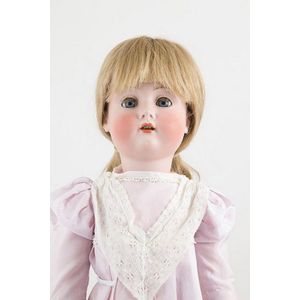Mahogany Bowfront Sideboard, Late 19th Century
You must be a subscriber, and be logged in to view price and dealer details.
Subscribe Now to view actual auction price for this item
When you subscribe, you have the option of setting the currency in which to display prices to $Au, $US, $NZ or Stg.
- Tapered Legs - found on both cabinet and country-made furniture from the 18th to the later 19th centuries. The leg sometimes terminates in a spade foot, though on most country furniture the taper continues for the whole length of the leg. The important thing to remember is that the taper ought only to be on the inside face of the leg, and the outer face should be straight and square. Some legs were made where both sides tapered, but in such a case the taper ought to be the same on both the inner and outer faces of the leg. Where the inside of a leg is straight, with only the outer face tapering, there is every reason to be suspicious
- Dummy Drawer - A drawer with facia decorations only, which is not operative.
- Mahogany - Mahogany is a dense, close grained red-coloured timber from the West Indies and Central America. It was first imported into Europe in the the early 18th century and its use continued through the 19th century. It was popular for furniture making because of its strength, the wide boards available, the distinctive grain on some boards, termed flame mahogany and the rich warm colour of the timber when it was polished.. The "flame" was produced where a limb grew out from the trunk of the tree, and this timber was usually sliced into veneers for feature panels on doors, backs and cornices.
Some terms used to describe mahogany relate to the country from which it originally came, such as "Cuban" mahogany, "Honduras" mahogany etc. However unless the wood has been tested the names assigned are more a selling feature, rather than a true indication of the timber's origin. - Thomas Sheraton - Thomas Sheraton (1751-1806) was born in Stockton on Tees in the north of England. He was apprenticed to a local cabinetmaker and after working as a cabinetmaker, Sheraton moved to London about 1790. Although he described himself as a cabinet-maker, like Chippendale, no definite piece of furniture can be traced to him as maker. Nevertheless, he was immensely influential and in 1791-4 published his four volume book 'The Cabinet-Maker and Upholsterer's Drawing Book'. The books were used as source of design by the furniture-making trade , who often simplified or modified the designs to suit their own preferences. Sheraton furniture is marked by restraint and sophistication, elegance and discretion, though he also found time to invent fanciful combination furniture.
- Tambour - A form of folding shutter formed by narrow widths of wood with the flat side glued to canvas, and used on some writing desks, sideboards and other cabinets.
The tambours may run vertically and enclose some stationery compartments, such as in a lady's writing desk. Or the tambours may run horizontally, such as in a Cutler desk, and form an enclosure for the whole of the writing surface.
This item has been included into following indexes:
Visually similar items

Antique Japanese carved ivory netsuke, of a man and dog on cushion

Simon & Halbig bisque doll, blue sleeping eyes, light brown real hair wig on ball jointed body 67 cm marked K * R Simon & Halbig 403 Germany 69

Two early European cavalry Sabres. Ex Fr Strange, Sydney, auction. I bearing tag 'French Cavalry Troopers Sabre C.1850,' (no scabbard), stamped Walschid Sclingen; & one other with scabbard. As inspected. Length 106 cm &. Length 103 cm

Canon: c1954 Canon IVSB2 (Leica-clone) screw-mount camera body (#197671) inscribed 'Canon Camera Company Inc. Japan' on top plate. Superb, virtually new condition in maker's Erc
